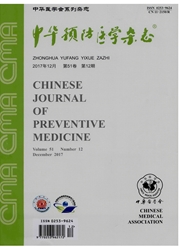

 中文摘要:
中文摘要:
目的 以微米氧化铝、纳米碳做对照,通过不同的细胞活力检测方法 观察纳米氧化铝对神经细胞活力的影响.方法 体外原代培养小鼠神经细胞,将纳米氧化铝、微米氧化铝、纳米碳均按正常对照组、62.5 μmol/L、125.0 μmol/L、250.0μmoL/L、500.0 μmol/L、1.0 mmol/L、2.0 mmol/L共7个剂量组分别染毒神经细胞,用细胞计数试剂(CCK-8)、噻唑蓝(MTT)及乳酸脱氢酶试剂(LDH)等方法 检测细胞活力[570 nm波长处的吸光度值(A570值)]的变化.结果 (1)CCK-8法检测结果 显示,250.0 μmol/L~2.0 mmol/L纳米氧化铝染毒组细胞活力(A570值分别为0.878±0.009、0.823±0.016、0.647±0.008、0.594 ±0.013)小于微米氧化铝染毒组(A570值分别为0.960±0.008、0.951±0.036、0.833 ±0.008、0.708±0.012)和纳米碳染毒组(A570值分别为0.977±0.003、0.973±0.002、0.924±0.006、0.891±0.023),差异具有统计学意义(同剂量组纳米氧化铝与微米氧化铝比较,t值分别为-0.082、-0.128、-0.186、-0.114,P值均〈0.01;与纳米碳比较,t值分别为-0.099、-0.150、-0.277、-0.297,P值均〈0.01).(2)MTT法检测结果 显示,在500.0 μmol/L、1.0 mmol/L剂量下,纳米氧化铝染毒组细胞活力(A570值分别为0.648±0.095、0.575±0.061)小于微米氧化铝染毒组(A570值分别为0.830±0.044、0.816±0.014)和纳米碳染毒组(A570值分别为0.889±0.009、0.765±0.049),差异具有统计学意义(同剂量组纳米氧化铝与微米氧化铝比较,t值分别为-0.183、-0.242,P值均〈0.01;与纳米碳比较,t值分别为-0.241、-0.190,P值均〈0.01).(3)LDH法检测的结果 显示,纳米氧化铝染毒组在125.0 μmol/L~2.0 mmol/L剂量下的细胞LDH释放量(A570值分别为1.862±0.102、1.905±0.066、1.930±0.037、1.946±0.033、1.967±0.068)高于纳米碳染毒组(A570值分别为1.484±0.110、1.559 ±0.039、1.663±0.014、1.732±0.076、1.765 ±0.073),差异具有统计学意义(t值分别?
 英文摘要:
英文摘要:
Objective To observe the effect of nano-alumina on nerve cell viability through different detection kits of cell viability, using micro-alumina and nano-carbon as controls. Methods Primary culturing nerve cells of mouse in vitro, which were exposed to 7 doses of 0 μmol/L, 62.5 μmol/L,125.0 μmol/L,250. 0 μmol/L,500. 0 μmol/L, 1.0 mmol/L,2. 0 mmol/L concentrations of nano-alumina (nano-Al) ,micro alumina (micro-Al) and nano-carbon (nano-C),detecting cell viability (A570 values) with CCK-8, MTT and LDH methods. Results (1) The results of CCK-8 kit showed that, in doses of 250. 0 μmol/L-2. 0 mmol/L,the cell viability values of nano-alumina (the values of A570 were 0. 878 ±0. 009,0. 823 ±0. 016,0. 647 ± 0. 008,0. 594 ± 0. 013, respectively) were significantly lower than that of micro-Al (the values of A570 were 0. 960 ± 0. 008,0. 951 ± 0. 036,0. 833 ± 0. 008,0. 708 ± 0. 012,respectively) and nano-C (the values of A570 were 0. 977 ± 0. 003,0. 973 ± 0. 002,0. 924 ± 0. 006,0. 891 ±0. 023, respectively). While, comparing nano-Al with the same dose of micro-Al, there was significant difference (the t values were - 0. 082, - 0. 128, - 0. 186, - 0. 114, respectively, P 〈 0. 01), and so as to the comparison of nano-Al with the same dose of nano-C (the t values were - 0. 099, - 0. 150, - 0. 277,-0. 297, respectively, P 〈 0. 01). (2) MTT results showed that in the doses of 500. 0 μmol/L and 1.0 mmol/L, the cell viability of nano-Al (the values of A570 were 0. 648 ± 0. 095 and 0. 575 ± 0. 061) were lower than that of micro-Al (the values of A570 were 0. 830 ± 0. 044 and 0. 816 ± 0. 014) and nano-C (the values of A570 were 0. 889 ± 0. 009 and 0. 765 ± 0. 049), and the differences were significant (nano-Al compared with the same dose of micro-Al, the t values were -0. 183 and -0.242,P〈0.01; nano-Al compared with the same dose of nano-C,the t values were -0.241 and -0. 190,P〈0.01). (3) LDH results showed that in the dose from 125.0 μmo
 同期刊论文项目
同期刊论文项目
 同项目期刊论文
同项目期刊论文
 期刊信息
期刊信息
